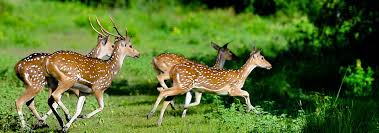The forest lies in the vast delta on the Bay of Bengal formed by the super confluence of the Ganges, Brahmaputra and Meghna rivers across Saiyan southern Bangladesh and West Bengal, India. The seasonally-flooded Sundarbans freshwater swamp forests lie inland from the mangrove forests on the coastal fringe. The forest covers 10,000 sq.km. of which about 6,000 are in Bangladesh.[2] It became inscribed as a UNESCO world heritage suite in 1997, but while the Bangladeshi and Indian portions constitute the same continuous ecotope, they are separately listed in the UNESCO world heritage list as the Sundarbans and Sundarbans National Park, respectively. The Bangladesh part of the Sundarbans is estimated to be about 4,110 km², of which about 1,700 km² is occupied by waterbodies in the forms of river, canals and creeks of width varying from a few meters to several kilometers.
General Information
AREA: Nearly 2400 sq. miles or 6000 sq. km.
Journey time:
It varies depending on tides against or in favour in the river. Usually it takes 6 to 10 hours journey by motor vessel from Mongla to Hiron Point or Katka.
Accommodation Inside the forest
FOREST LIMITS:
North-Bagerhat, Khulna and Sathkira districts : South-Bay of Bengal; East-Baleswar (or Haringhata) river, Perojpur, Barisal district, and West-Raimangal and Hariabhanga rivers which partially form Bangladesh boundary with West Bengal in India.
MAIN ATTRACTIONS:
Wildlife photography including photography of the famous Royal Bengal Tiger, wildlife viewing, boating inside the forest will call recordings, nature study, meeting fishermen, wood-cutters and honey-collectors, peace and tranquility in the wilderness, seeing the world's largest mangrove forest and the riverine beauty.
FAMOUS SPOTS:
Hiron Point (Nilkamal) for tiger, deer, monkey, crocodiles, birds and natural beauty. Katka for deer, tiger, crocodiles, varieties of birds and monkey, morning and evening symphony of wild fowls. Vast expanse of grassy meadows running from Katka to Kachikhali (Tiger Point) provide opportunities for wild tracking.
Tin Kona Island for tiger and deer.
Dublar Char (Island) for fishermen. It is a beautiful island where herds of spotted deer are often seen to graze.
Means of Communication:
Water transport is the only means of communication for visiting the Sundarbans from Khulna or Mongla Port. Private motor launch, speed boats, country boats as well as mechanised vessel of Mongla Port Authority might be hired for the purpose. From Dhaka visitors may travel by air, road or rocket steamer to Khulna - the gateway to the Sundarbans. Most pleasant journey from Dhaka to Khulna is by Paddle Steamer, Rocket presenting a picturesque panorama of rural Bangladesh. Day and night-long coach services by road are also available. The quickest mode is by air from Dhaka to Jessore and then to Khulna by road.
Hiron Point :
Comfortable three-storied Rest-House of the Mongla Port Authority. Prior booking is to be made.
Katka :
Forest Department Rest-House located here. Prior booking essential.
Journey by Rocket Steamer to Mongla and Khulna
Minimum Journey time is 22 Hours for Mongla and 24 Hours for Khulna from Dhaka.
Entry Permission:
Prior permission must be obtained through written application from the Divisional Forest Office, Circuit House Road, Khulna (Phone 20665, 211731) to visit the Sundarbans. Required entrance fees for visitors, vessel or boat payable at the relevant forest station/range office.
Fee for Commercial Photography
Movie Tk. 5,000.00 per role exposed
Video Tk. 4,000.00 per Cassette
Still Tk. 1,000.00 per role exposed
Guided Tours:
Bangladesh Parjatan Corporation & other tour operators offers all-inclusive guided package fours from Dhaka to Sundarbans and return during the tourist season (October to March).
Climate:
Climate in the Sundarbans is moderate. Air is humid. Full monsoon is from June to September. The annual rainfall average between 65" and 70". During ebb-tide the forest becomes bare by 6-7 feet and at high tide (30 miles and hour) the entire territory of the forest floats on water.
Life in Forest:
Only means of transportation inside the forest is boat. There is no road, no trail of a path anywhere. The wood-cutters make temporary dwellings at the edge of the forest at a height of 8-10 feet for fear of wild animals others live on boats. In the chandpai region it is fascinating to see the nomadic fishermen (living with families on boats) catching fish with the help of trained offers. Exciting activities take place in Dublar Char in the forest where fishermen from Chittagong gather for four months (mid Oct. to mid Feb.) to catch and dry fish. But the most daring and exciting of all activities is presented by the honey-collectors who work in groups for just two months (April-May) and it is interesting to see how they locate a hive and then collect honey.
Flora and Fauna:
The Sundarbans is endowed by nature with rich flora and fauna. It is a wonderful place to see or to shoot a Royal Bengal Tiger with Camera if one has the time to wait in the forest. There are a good number of tigers in the Sundarbans. Lovely spotted deer are easy to find. Besides there are a wide variety of wildlife for which the Sundarbans is so famous
Visit to the Forest













No comments:
Post a Comment